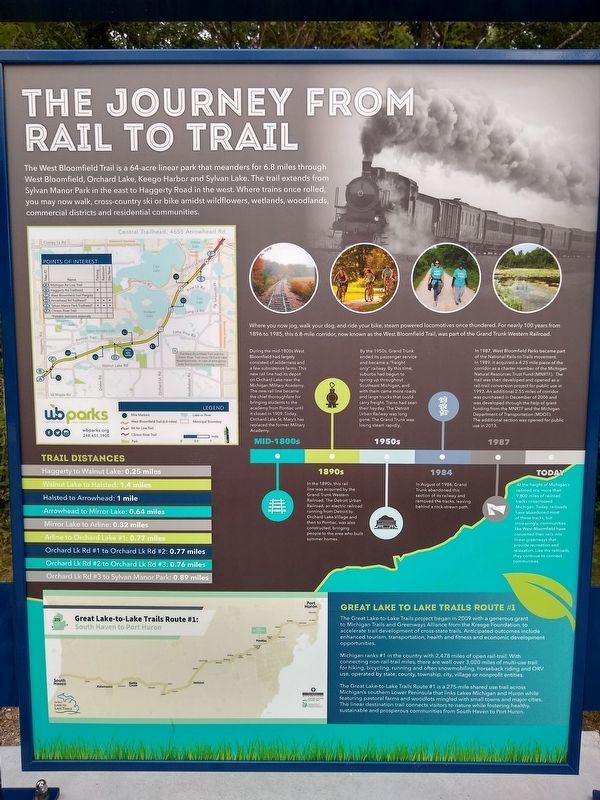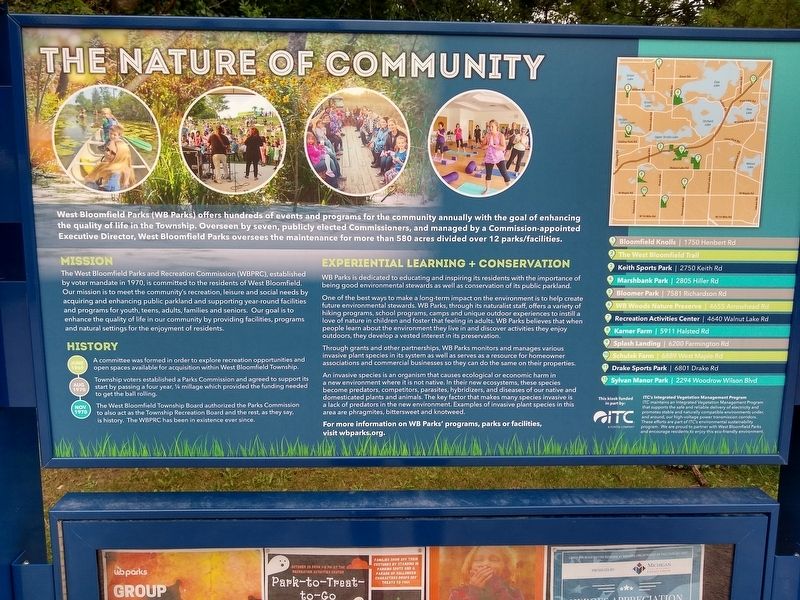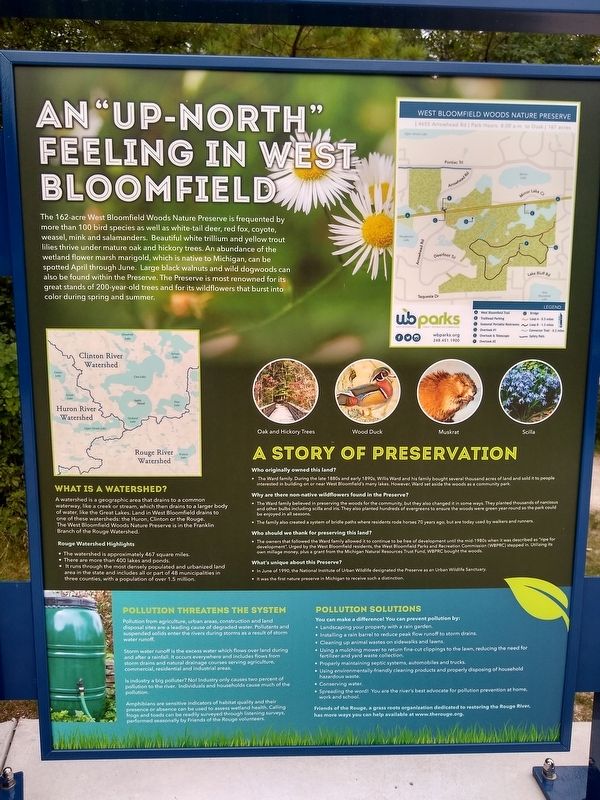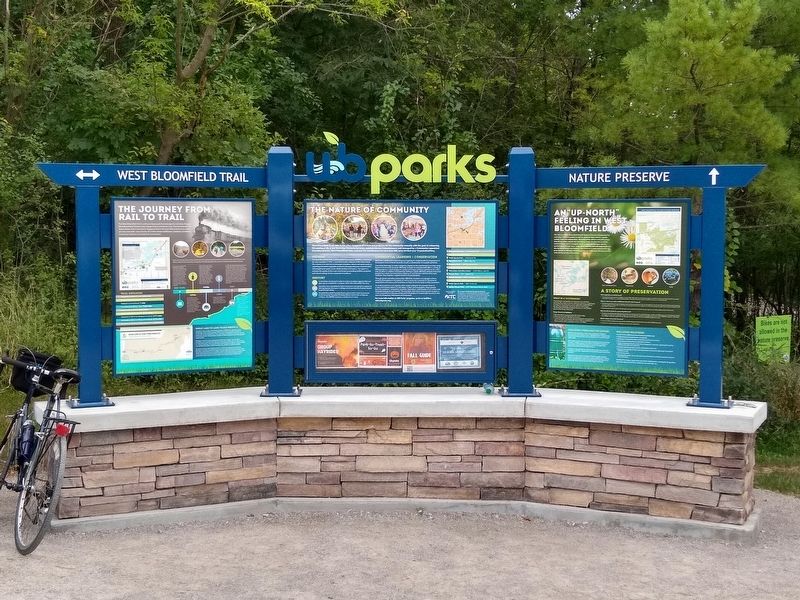West Bloomfield in Oakland County, Michigan — The American Midwest (Great Lakes)
WB Parks Kiosk
Inscription.
The Journey from Rail to Trail (left panel)
The West Bloomfield Trail is a 64-acre linear park that meanders for 6.8 miles through West Bloomfield, Orchard Lake, Keego Harbor and Sylvan Lake. The trail extends from Sylvan Manor Park in the east to Haggerty Road in the west. Where trains once rolled, you may now walk, cross-country ski or bike amidst wildflowers, wetlands, woodlands, commercial districts and residential communities.
WHere you now jog, walk your dog, and ride your bike, steam powered locomotives once thundered. For nearly 100 years from 1896 to 1985, this 6.8-mile corridor, now known as the West Bloomfield Trail, was part of the Grand Trunk Western Railroad.
Mid-1800s
During the mid-1800s West Bloomfield had largely consisted of wilderness and a few subsistence farms. This new rail line had its depot on Orchard Lake near the Michigan Military Academy. The new rail line became the chief thoroughfare for bringing students to the academy from Pontiac until it closed in 1909. Today, Orchard Lake St. Mary's has replaced the former Military Academy.
1890s
In the 1890s, this rail line was acquired by the Grand Trunk Western Railroad. The Detroit Urban Railroad, an electric railroad running from Detroit to Orchard Lake Village and then to Pontiac, was also constructed, bringing people to the area who built summer homes.
1950s
By the 1950s, Grank Trunk ended its passenger service and became a "freight only" railway. By this time, suburbs had begun to spring up throughout Southeast Michigan, and with them came more roads and large trucks that could carry freight. Trains had seen their heyday. The Detroit Urban Railway was long gone. The Grand Trunk was losing steam rapidly.
1984
In August of 1984, Grand Trunk abandoned this section of its railway and removed the tracks, leaving behind a rock-strewn path.
1987
In 1987, West Bloomfield Parks became part of the National Rails-to-Trails movement. In 1989, it acquired a 4.25 mile piece of the corridor as a charter member of the Michigan Natural Resources Trust Fund (MNRTF). The trail was then developed and opened as a rail-trail conversion project for public use in 1993. An additional 2.55 miles of corridor was purchased in December of 2006 and was developed through the help of grant funding from the MNRFT and the Michigan Department of Transportation (MDOT). The additional section was opened for public use in 2013.
Today
At the height of Michigan's railroad era, more than 9,800 miles of railroad tracks crisscrossed Michigan. Today, railroads have abandoned most of these tracks, but increasingly,
communities like West Bloomfield have converted their rails into linear greenways that provide recreation and relaxation. Like the railroads, they continue to connect communities.
Trail Distances
Haggerty to Walnut Lake: 0.25 miles
Walnut Lake to Halsted: 1.4 miles
Halsted to Arrowhead: 1 mile
Arrowhead to Mirror Lake: 0.64 miles
Mirror Lake to Arline: 0.32 miles
Arline to Orchard Lake #1: 0.77 miles
Orchard Lk Rd #1 to Orchard Lk Rd #2: 0.77 miles
Orchard Lk Rd #2 to Orchard Lk Rd #3: 0.76 miles
Orchard Lk Rd #3 to Sylvan Manor Park: 0.89 miles
Great Lake to Lake Trails Route #1
The Great Lake-to-Lake Trails project began in 2009 with a generous grant to Michigan Trails and Greenways Alliance from the Kresge Foundation, to accelerate trail development of cross-state trails. Anticipated outcomes include enhanced tourism, transportation, health and fitness and economic development opportunities.
The Great Lake-to-Lake Trails Route #1 is a 275-mile shared use trail
across Michigan's southern Lower Peninsula that links Lakes Michigan and Huron while featuring pastoral farms and woodlots mingled with small towns and major cities. The linear trail connects visitors to nature while fostering healthy, sustainable and prosperous communities from South Haven to Port Huron.
The Nature of Community (middle panel)
West Bloomfield Parks (WB Parks) offers hundreds of events and programs for the community annually with the goal of enhancing the quality of life in the Township. Overseen by seven, publicly elected Commissioners, and managed by a Commission-appointed Executive Director, West Bloomfield Parks oversees the maintenance for more than 580 acres divided over 12 parks/facilities.
Mission The West Bloomfield Parks and Recreation Commission (WBPRC), established by voter mandate in 1970, is committed to the residents of West Bloomfield. Our mission is to meet the community's recreation, leisure and social needs by acquiring and enhancing public parkland and supporting year-round facilities and programs for youth, teens, adults, families and seniors. Our goal is to enhance the quality of life in our community by providing facilities, programs and natural settings for the enjoyment of residents.
History
June 1969 A committee was formed in order to explore recreation opportunities and open spaces available for acquisition within West Bloomfield Township.
Aug 1970 Township voters established a Parks Commission and agreed to support its start by passing a four year, Ό millage which provided the funding needed to get the ball rolling.
Nov 1970 The West Bloomfield Township Board authorized the Parks Commission to also act as the Township Recreation Board and the rest, as they say, is history. The WBPRC has been in existence ever since.
Experiential Learning + Conservation
WB Parks is dedicated to educating and inspiring its residents with the importance of being good environmental stewards as well as conservation of its public parkland.
One of the best ways to make a long-term impact on the environment is to help create future environmental stewards. WB Parks, through its naturalist staff, offers a variety of hiking programs, school programs, camps and unique outdoor experiences to instill a love of nature in children and foster that feeling in adults. WB Parks believes that when people learn about the environment they live in and discover activities they enjoy outdoors, they develop a vested interest in its preservation.
Through grants and other partnerships, WB Parks monitors and manages various invasive plant species in its system as well as serves as a resource for homeowner associations and commercial businesses so they can do the same on their properties.
An invasive species is an organism that causes ecological or economic harm in a new environment where it is not native. In their new ecosystems, these species become predators, competitors, parasites, hybridizers, and diseases of our native and domesticated plants and animals. The key factor that makes many species invasive is a lack of predators in the new environment. Examples of invasive plant species in this area are phragmites, bittersweet and knotweed.
For more infomation on WB Parks' programs, parks or facilities, visit wbparks.org.
1 Bloomfield Knolls 1750 Henbert Rd
2 The West Bloomfield Trail
3 Keith Sports Park 2750 Keith Rd
4 Marshbank Park 2805 Hiller Rd
5 Bloomer Park 7581 Richardson Rd
6 WB Woods Nature Preserve 4655 Arrowhead Rd
7 Recreation Activities Center 4640 Walnut Lake Rd
8 Karner Farm 5911 Halsted Rd
9 Splash Landing 6200 Farmington Rd
10 Schulak Farm 6889 West Maple Rd
11 Drake Sports Park 6801 Drake Rd
12 Sylvan Manor Park 2294 Woodrow Wilson Blvd.
This kiosk funded in part by: ITC
ITC's Integrated Vegetation Management Program
ITC maintains an Integrated Vegetation Management Program that supports the safe and reliable delivery of electricity and promotes stable and naturally compatible environments under, and around, our high-voltage power transmission corridors. These efforts are part of ITC's environmental sustainability program. We are proud to partner with West Bloomfield Parks and encourage residents to enjoy this eco-friendly environment.
An "Up-North" Feeling in West Bloomfield (right panel)
The 162-acre West Bloomfield Woods Nature Preserve is frequented by more than 100 bird species as well as white-tail deer, red fox, coyote, weasel, mink and salamanders. Beautiful white trillium and yellow trout lilies thrive under mature oak and hickory trees. An abundance of the wetland flower marsh marigold, which is native to Michigan, can be spotted April thorugh June. Large black walnuts and wild dogwoods can also be found within the Preserve. The Preserve is most renowned for its great stands of 200-year-old trees and for its wildflowers that burst into color during spring and summer.
A Story of Preservation
Who originally owned this land?
The Ward family. During the late 1880s and early 1890s, Willis Ward and his family bought several thousand acres of land and sold it to people interested in building on or near West Bloomfield's many lakes. However, Ward set aside the woods as a community park.
Why are there non-native wildflowers found in the Preserve?
The Ward family believed in preserving the woods for the community, but they also changed it in some ways. They planted thousands of narcissus and other bulbs including scilla and iris. They also planted hundreds of evergreens to ensure the woods were green year-round so the park could be enjoyed in all seasons.
Who should we thank for preserving this land?
The owners that followed the Ward family allowed it to continue to be free of development until the mid-1980s when it was described as "ripe for development". Urged by the West Bloomfield residents, the West Bloomfield Parks and Recreation Commission (WBPRC) stepped in. Utilizing its own millage money, plus a grant from the Michigan Natural Resources Trust Fund, WBPRC bought the woods.
What's unique about this Preserve?
In June of 1990, the National Institute of Urban Wildlife designated the Preserve as an Urban Wildlife Sanctuary.
It was the first nature preserve in Michigan to receive such a distincction.
What is a Watershed?
A watershed is a geographic area that drains to a common waterway, like a creek or stream, which then drains to a larger body of water, like the Great Lakes. Land in West Bloomfield drains to one of these watersheds: the Huron, Clinton or the Rouge. The West Bloomfield Woods Nature Preserve is in the Franklin Branch of the Rouge Watershed.
Rouge Watershed Highlights
The watershed is approximately 467 square miles.
There are more than 400 lakes and ponds.
It runs through the most densely populated and urbanized land area in the state and includes all or part of 48 municipalities in three counties, with a population of over 1.5 million.
Pollution Threatens the System Pollution from agriculture, urban areas, construction and land disposal sites are a leading cause of degraded water. Pollutants and suspended solids enter the rivers during storms as a result of storm water runoff.
Storm water runoff is the excess water which flows over land during and after a rainfall. It occurs everywhere and includes flows from storm drains and natural drainage courses serving agriculture, commercial, residential and industrial areas.
Is industry a big polluter? No! Industry only causes two percent of pollution to the river. Individuals and households cause much of the pollution.
Amphibians are sensitive indicators of habitat quality and their presence or absence can be used to assess wetland health. Calling frogs and toads can be readily surveyed through listening surveys, performed seasonally by Friends of the Rouge volunteers.
Pollution Solutions
You can make a difference! You can prevent pollution by:
Landscaping your property with a rain garden.
Installing a rain barrel to reduce peak flow runoff to storm drains.
Cleaning up animal wastes on sidewalks and lawns.
Using a mulching mower to return fine-cut clippings to the lawn, reducing the need for fertilizer and yard waste collection.
Properly maintaining septic systems, automobiles and trucks.
Using environmentally-friendly cleaning products and properlly disposing of household hazardous waste.
Conserving water.
Spreading the word! You are the river's best advocate for pollution prevention at home, work and school.
Friends of the Rouge, a grass roots organization dedicated to restoring the Rouge River, has more ways you can help available at www.therouge.org.
Erected by West Bloomfield Parks and Recreation Commission.
Topics. This historical marker is listed in this topic list: Environment. A significant historical month for this entry is June 1969.
Location. 42° 34.069′ N, 83° 23.585′ W. Marker is in West Bloomfield, Michigan, in Oakland County. Marker is on Arrowhead Road, 0.3 miles south of Pontiac Trail, on the left when traveling south. Marker is along the West Bloomfield Trail at the entrance to West Bloomfield Woods Nature Preserve. Touch for map. Marker is at or near this postal address: 4655 Arrowhead Road, West Bloomfield MI 48323, United States of America. Touch for directions.
Other nearby markers. At least 8 other markers are within 2 miles of this marker, measured as the crow flies. Settling the Dust (a few steps from this marker); An Advocate for Parks (within shouting distance of this marker); The Great Blues (approx. 0.4 miles away); Go in Peace (approx. 0.6 miles away); Emmendorfer House / Francis A. Emmendorfer (approx. 1.6 miles away); Remembering Historic Railways (approx. 1.7 miles away); Chief Pontiac (approx. 1.9 miles away); Orchard Lake Chapel (approx. 1.9 miles away). Touch for a list and map of all markers in West Bloomfield.
Credits. This page was last revised on July 8, 2021. It was originally submitted on July 8, 2021, by Joel Seewald of Madison Heights, Michigan. This page has been viewed 172 times since then and 16 times this year. Photos: 1, 2, 3, 4. submitted on July 8, 2021, by Joel Seewald of Madison Heights, Michigan.



